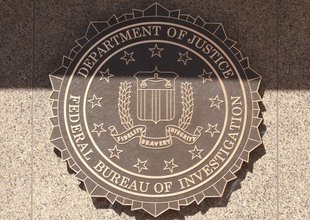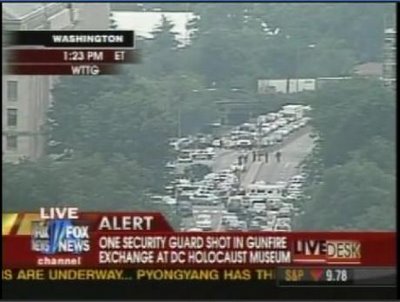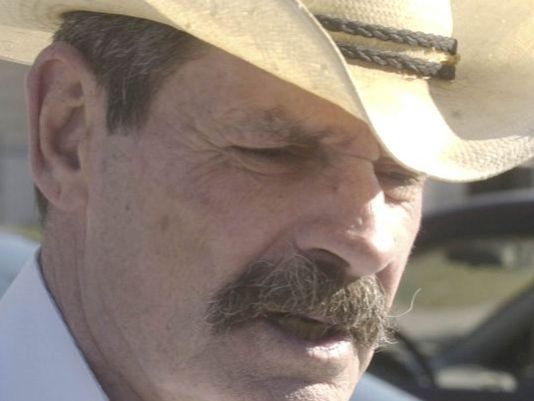Alex Constantine - June 28, 2007
Inconvenient Truths
Hugh Miles
London Review of Books
http://www.lrb.co.uk/v29/n12/print/mile01_.html
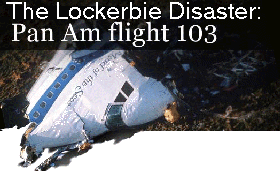 On 21 December 1988, Pan Am Flight 103 was 38 minutes into its journey when it was blown up at 31,000 feet. The explosion was so powerful that the nose of the aircraft was torn clean off. Within three seconds of the bomb detonating, the cockpit, fuselage and No. 3 engine were falling separately out of the sky. It happened so quickly that no distress call was sent out and no oxygen masks deployed. With the cockpit gone, the fuselage depressurised instantly and the passengers in the rear section of the aircraft found themselves staring out into the Scottish night air. Anyone or anything not strapped down was whipped out of the plane; the change in air pressure made the passengers’ lungs expand to four times their normal volume and everyone lost consciousness. As the fuselage plummeted and the air pressure began to return to normal, some passengers came round, including the captain. A few survived all the way down, until they hit the ground. Rescuers found them clutching crucifixes, or holding hands, still strapped into their seats.
On 21 December 1988, Pan Am Flight 103 was 38 minutes into its journey when it was blown up at 31,000 feet. The explosion was so powerful that the nose of the aircraft was torn clean off. Within three seconds of the bomb detonating, the cockpit, fuselage and No. 3 engine were falling separately out of the sky. It happened so quickly that no distress call was sent out and no oxygen masks deployed. With the cockpit gone, the fuselage depressurised instantly and the passengers in the rear section of the aircraft found themselves staring out into the Scottish night air. Anyone or anything not strapped down was whipped out of the plane; the change in air pressure made the passengers’ lungs expand to four times their normal volume and everyone lost consciousness. As the fuselage plummeted and the air pressure began to return to normal, some passengers came round, including the captain. A few survived all the way down, until they hit the ground. Rescuers found them clutching crucifixes, or holding hands, still strapped into their seats.
The fuselage of the plane landed on a row of family houses in the small Scottish town of Lockerbie. The impact was so powerful that the British Geological Survey registered a seismic event measuring 1.6 on the Richter scale. The wing section of the Boeing 747, loaded with enough fuel for a transatlantic flight, hit the ground at more than 500 miles an hour and exploded in a fireball that lit the sky. The cockpit, with the first-class section still attached, landed beside a church in the village of Tundergarth.
Over the next few days rescuers made a fingertip search of the crash site: 243 passengers, 16 crew members and 11 people on the ground had been killed. Bodies and debris were strewn along an 81-mile corridor of Scottish countryside. Ten thousand pieces of debris were retrieved; each was meticulously logged. Among the items recovered were the remains of a Samsonite suitcase, which investigators later established had been used to transport the bomb. The suitcase had contained clothes, clothes that were subsequently traced to the shop of a Maltese man called Tony Gauci. Gauci later became a key prosecution witness. Fragments of a circuit board and a Toshiba radio were also recovered and identified as parts of the bomb.
Twelve years later, on 31 January 2001, a panel of three Scottish judges convicted a former Libyan intelligence officer for mass murder at Lockerbie. Abdelbaset Ali al-Megrahi was tried at a specially convened court on a former US air force base near the Dutch town of Zeist. Under a special international arrangement, the court, which sat without a jury, was temporarily declared sovereign territory of the United Kingdom, under the jurisdiction of Scottish law.
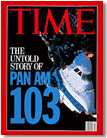 Al-Megrahi is still the only person to have been found guilty in connection with the attack. He was sentenced to 27 years in jail. His co-accused, Al Amin Khalifa Fhimah, a fellow Libyan intelligence officer, was acquitted. Al-Megrahi was initially told that he would spend at least twenty years in prison, but the Crown, which was prosecuting, protested that this sentence was unduly lenient and petitioned the judges for a longer one. In 2003 the judges reconvened to rule that he must serve no less than 27 years before the parole board would consider his eligibility for release. Al-Megrahi’s defence team had already lodged an appeal against the conviction, but in March 2002 the guilty verdict was upheld.
Al-Megrahi is still the only person to have been found guilty in connection with the attack. He was sentenced to 27 years in jail. His co-accused, Al Amin Khalifa Fhimah, a fellow Libyan intelligence officer, was acquitted. Al-Megrahi was initially told that he would spend at least twenty years in prison, but the Crown, which was prosecuting, protested that this sentence was unduly lenient and petitioned the judges for a longer one. In 2003 the judges reconvened to rule that he must serve no less than 27 years before the parole board would consider his eligibility for release. Al-Megrahi’s defence team had already lodged an appeal against the conviction, but in March 2002 the guilty verdict was upheld.
From the outset the Lockerbie disaster has been marked by superlatives. The bombing was the deadliest terror attack on American civilians until 11 September 2001. It sparked Britain’s biggest ever criminal inquiry, led by its smallest police force, Dumfries and Galloway Constabulary. It spelled the end of Pan Am, which never recovered from the damage to its reputation. The trial at Camp Zeist was the longest and – at a cost of £75 million – the most expensive in Scottish legal history. The appeal hearing was the first Scottish trial to be broadcast live on both television and the internet.
Lawyers, politicians, diplomats and relatives of Lockerbie victims now believe that the former Libyan intelligence officer is innocent. Robert Black QC, an emeritus professor of Scottish law at Edinburgh University, was one of the architects of the original trial in Holland. He has closely followed developments since the disaster happened and in 2000 devised the non-jury trial system for the al-Megrahi case.
Even before the trial he was so sure the evidence against al-Megrahi would not stand up in court that he is on record as saying that a conviction would be impossible. When I asked how he feels about this remark now, Black replied: ‘I am still absolutely convinced that I am right. No reasonable tribunal, on the evidence heard at the original trial, should or could have convicted him and it is an absolute disgrace and outrage what the Scottish court did.’
Al-Megrahi lost his appeal in 2002, but under Scottish law he is entitled to a further legal review, to be conducted by the Scottish Criminal Cases Review Commission (SCCRC), an independent public body made up of senior police officers and lawyers. Its job is to re-examine cases where a miscarriage of justice may have occurred: it handles cases after the appeal process has been exhausted, and if it finds evidence that a miscarriage of justice may have taken place it refers the case to the High Court to be heard again. Al-Megrahi applied to the SCCRC for a review of his case in 2003 and the commission has been reinspecting evidence from the trial for the last four years. It will submit its findings at the end of June. It looks likely that the SCCRC will find that there is enough evidence to refer al-Megrahi’s case back to the appeal court. The Crown Office has already begun reinforcing its Lockerbie legal team in anticipation of a referral.
If al-Megrahi is granted a second appeal, it will, like the original trial, be held before a panel of Scottish judges, without a jury. This time the trial will take place in Scotland, and if the glacial pace of proceedings in the past is anything to go by, it will probably not be heard before the summer of 2008. Al-Megrahi’s defence team would be ready to launch an appeal in a matter of weeks, but the prosecution would be likely to delay the hearing for as long as possible. If an appeal takes place, al-Megrahi’s defence team will produce important evidence that was not available at the time of the first appeal, evidence that seems likely not only to exonerate al-Megrahi but to do so by pointing the finger of blame at the real perpetrators of the Lockerbie bombing and revealing some inconvenient truths.
Even the judge who presided over the Lockerbie investigation and issued the 1991 arrest warrants for the two Libyans has cast doubt on the prosecution’s case. In an interview with the Sunday Times in October 2005, Lord Fraser of Carmyllie, Scotland’s larger-than-life lord advocate from 1989 to 1992, questioned the reliability of the shopkeeper Tony Gauci, the prosecution’s star witness. ‘Gauci was not quite the full shilling. I think even his family would say [that he] was an apple short of a picnic. He was quite a tricky guy, I don’t think he was deliberately lying but if you asked him the same question three times he would just get irritated and refuse to answer.’ Lord Fraser made it clear that this did not mean he thought al-Megrahi was innocent. But he had presented Gauci as a reliable witness; he went on to become the heart of the prosecution’s case. Now he was casting doubt on the man who identified al-Megrahi.
Since al-Megrahi’s last appeal, many thousands of pages of reports, detailing freight and baggage movements in and out of Frankfurt airport, have been handed over to the defence. Largely in German and many handwritten, the papers were translated by the Crown at the taxpayer’s expense, but the Crown refused to share the translations with the defence and left it no time to commission its own. The Privy Council’s judicial committee, made up of law lords and senior judges, has declared that the Crown’s refusal to disclose this evidence is a breach of the European Convention on Human Rights. More damaging still, an unnamed senior British police officer – known to be a member of the Association of Chief Police Officers in Scotland (ACPOS), which implies that his rank is assistant chief constable or higher – has testfied to al-Megrahi’s defence team that crucial evidence at the trial was fabricated. If the SCCRC finds that the prosecution played foul, the Crown may decide it would be better not to continue with its case, allowing al-Megrahi to be freed immediately.
This anonymous senior officer’s testimony chimes with the well-trodden theory that the American government had a hand in fixing the trial. Hans Köchler, the UN observer at Camp Zeist, reported at the time that the trial was politically charged and the verdict ‘totally incomprehensible’.
In his report Köchler wrote that he found the presence of US Justice Department representatives in the court ‘highly problematic’, because it gave the impression that they were ‘“supervisors” handling vital matters of the prosecution strategy and deciding . . . which documents . . . were to be released in open court and what parts of information contained in a certain document were to be withheld.’ ‘The alternative theory of the defence,’ he went on, ‘was never seriously investigated. Amid shrouds of secrecy and national security considerations, that avenue was never seriously pursued – although it was officially declared as being of major importance for the defence case. This is totally incomprehensible to any rational observer.’ The prosecution, Köchler noted, dismissed evidence on the grounds that it was not relevant; but now that that evidence has finally – partially – been released, it turns out to be very relevant indeed: to the defence.
Whatever happens, al-Megrahi may not have to wait long. As soon as a further appeal is scheduled, he can make an application to be released from custody: the convicted Lockerbie bomber, who was supposed to serve no fewer than 27 years in a Scottish jail, might well be free this summer. Whether al-Megrahi is freed pending his appeal – and what conditions would be applied if he were – depends largely on whether his defence team can convince the judge that he is not a flight risk. This may be hard to do. The judge might decide that if he left the country, he might choose to stay in Libya rather than come back next year for another round in court. If al-Megrahi is exonerated, many tricky questions will resurface, not least what to do about the $2.7 billion compensation paid by Libya to the relatives of the victims of the bombing. And then, of course, there is the question of who really bombed Flight 103.
In the first three years following the bombing, before a shred of evidence had been produced to incriminate Libya, the Dumfries and Galloway police, the FBI and several other intelligence services around the world all shared the belief that the Lockerbie bombers belonged to the Popular Front for the Liberation of Palestine General Command (PFLP-GC), a Palestinian rejectionist organisation backed by Iran. The PFLP-GC is headed by Ahmed Jibril, a former Syrian army captain; its headquarters are in Damascus and it is closely allied with the Syrian president and other senior Syrian officials. In the 1970s and 1980s the PFLP-GC carried out a number of raids against Israel, including a novel hang-glider assault launched from inside Lebanon. Lawyers, intelligence services and diplomats around the world continue to suspect that Jibril – who has even boasted that he is responsible – was behind Lockerbie.
The case against Jibril and his gang is well established. It runs like this: in July 1988, five months before the Lockerbie bombing, a US naval commander aboard USS Vincennes in the Persian Gulf shot down an Iranian airbus, apparently mistaking it for an attacker. On board Iran Air Flight 655 were 270 pilgrims en route to Mecca. Ayatollah Khomeini vowed the skies would ‘rain blood’ in revenge and offered a $10 million reward to anyone who ‘obtained justice’ for Iran. The suggestion is that the PFLP-GC was commissioned to undertake a retaliatory bombing.
We know at least that two months before Lockerbie, a PFLP-GC cell was active in the Frankfurt and Neuss areas of West Germany. On 26 October 1998, German police arrested 17 terrorist suspects who, surveillance showed, had cased Frankfurt airport and browsed Pan Am flight timetables. Four Semtex-based explosive devices were confiscated; a fifth is known to have gone missing. They were concealed inside Toshiba radios very similar to the one found at Lockerbie a few weeks later. One of the gang, a Palestinian known as Abu Talb, was later found to have a calendar in his flat in Sweden with the date of 21 December circled. New evidence, now in the hands of al-Megrahi’s defence, proves for the first time that Abu Talb was in Malta when the Lockerbie bombing took place. The Maltese man whose testimony convicted al-Megrahi has also identified Abu Talb. During al-Megrahi’s trial Abu Talb had a strange role. As part of a defence available in Scottish law, known as ‘incrimination’, Abu Talb was named as someone who – rather than the accused – might have carried out the bombing. At the time he was serving a life sentence in Sweden for the bombing of a synagogue, but he was summoned to Camp Zeist to give evidence. He ended up testifying as a prosecution witness, denying that he had anything to do with Lockerbie. In exchange for his testimony, he received lifelong immunity from prosecution.
Other evidence has emerged showing that the bomb could have been placed on the plane at Frankfurt airport, a possibility that the prosecution in al-Megrahi’s trial consistently ruled out (their case depended on the suitcase containing the bomb having been transferred from a connecting flight from Malta). Most significantly, German federal police have provided financial records showing that on 23 December 1988, two days after the bombing, the Iranian government deposited £5.9 million into a Swiss bank account that belonged to the arrested members of the PFLP-GC.
The decision to steer the investigation away from the PFLP-GC and in the direction of Libya came in the run-up to the first Gulf War, as America was looking to rally a coalition to liberate Kuwait and was calling for support from Iran and Syria. Syria subsequently joined the UN forces. Quietly, the evidence incriminating Jibril, so painstakingly sifted from the debris, was binned.
Those who continued to press the case against the PFLP-GC seemed to fall foul of American law. When a New York corporate investigative company asked to look into the bombing on behalf of Pan Am found the PFLP-GC responsible, the federal government promptly indicted the company’s president, Juval Aviv, for mail fraud. Lester Coleman, a former Defense Intelligence Agency operative who was researching a book about the PFLP-GC and Lockerbie, was charged by the FBI with ‘falsely procuring a passport’. William Casey, a lobbyist who made similar allegations in 1995, found his bank accounts frozen and federal agents searching through his trash. Even so, documents leaked from the US Defense Intelligence Agency in 1995, two years after the Libyans were first identified as the prime suspects, still blamed the PFLP-GC.
Suspicions and conspiracy theories have swirled around Lockerbie from the beginning. Some of them are fairly outlandish. In Diplomatic Baggage: The Adventures of a Trailing Spouse (2005), Brigid Keenan, the wife of the British diplomat Alan Waddams, reported that over dinner in Gambia, a former Interpol agent told her and her husband that the bombing had been a revenge attack by Iran, in retaliation for the downed airliner (though she didn’t say how he knew this). The Interpol agent claimed the cargo had not been checked because the plane was carrying drugs as part of a deal over American hostages held by Hizbullah in Beirut. Militant groups were being allowed to smuggle heroin into the US in exchange for information; the bomb had gone on board when the PFLP-GC found a loophole in this drug-running operation.
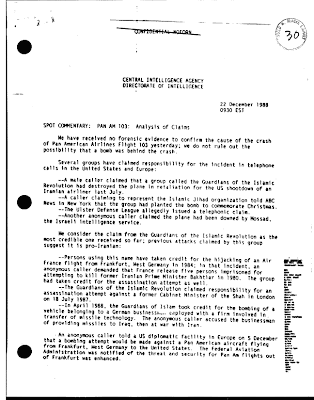 At least four US intelligence officers, including the CIA’s deputy station chief in Beirut, were on the Flight 103 passenger list. In the days following the bombing, CIA agents scoured the Scottish countryside, some reportedly dressed in Pan Am overalls. Mary Boylan, then a constable with Lothian and Borders police, has said that senior police officers told her not to make an official record of the CIA badge she recovered from the wreckage, asking her instead to hand it over to a senior colleague. Her testimony, too, is now in the hands of the SCCRC. Jim Wilson, a farmer from the village of Tundergarth, reported shortly after the bombing that he had found in his field a suitcase packed with a powdery substance that looked ‘like drugs’. He last saw the suitcase when he handed it over to the police, he said; he was never asked about it again.
At least four US intelligence officers, including the CIA’s deputy station chief in Beirut, were on the Flight 103 passenger list. In the days following the bombing, CIA agents scoured the Scottish countryside, some reportedly dressed in Pan Am overalls. Mary Boylan, then a constable with Lothian and Borders police, has said that senior police officers told her not to make an official record of the CIA badge she recovered from the wreckage, asking her instead to hand it over to a senior colleague. Her testimony, too, is now in the hands of the SCCRC. Jim Wilson, a farmer from the village of Tundergarth, reported shortly after the bombing that he had found in his field a suitcase packed with a powdery substance that looked ‘like drugs’. He last saw the suitcase when he handed it over to the police, he said; he was never asked about it again.
In December 1998, Susan Lindauer, a US congressional aide, submitted a sworn deposition to the court in which she claimed that Richard Fuisz, a CIA agent, had given her a guarantee that he knew who was behind the Lockerbie bombing. Lindauer’s affidavit describes a conversation in Fuisz’s ‘business office’ in Chantilly, Virginia, in which he said he knew for sure the perpetrators were based in Syria. ‘Dr Fuisz has told me that he can identify who orchestrated and executed the bombing. Dr Fuisz has said that he can confirm absolutely that no Libyan national was involved in planning or executing the bombing of Pan Am 103, either in any technical or advisory capacity whatsoever.’ ‘If the government would let me, I could identify the men behind this attack,’ Lindauer says Fuisz told her. Lindauer has since been accused by the US government of being an Iraqi agent; her case is pending. But her earlier deposition has been submitted to the SCCRC. It can’t count for much, however, since Fuisz himself is not able to comment. In October 1994, a month after Lindauer spoke to him, Fuisz was gagged by a Washington court. The US government ruled that under state secrecy laws he faced ten years in prison if he spoke about the Lockerbie bombing. UN observers have since criticised this apparent restraint of a key witness.
When Libya handed al-Megrahi over for trial, sanctions on Libya authorised by the Security Council were suspended and diplomatic relations with Britain restored. Tony Blair claims the Libyan detente was one of his most important foreign policy victories, and last month, as the long shadow began to fall across his premiership, Blair swung by Tripoli to meet again with Libya’s leader. Gaddafi has always contested that al-Megrahi is not the Lockerbie bomber and that he should be allowed to return home. Maybe the two leaders touched on the prickly topic of what should be done about the compensation paid by Libya, in the event al-Megrahi is exonerated. When al-Megrahi was handed over for trial, Libya declared that it would accept responsibility for his actions. But it never accepted guilt. This distinction was spelled out clearly in Libyan letters to the UN Security Council. In a BBC radio interview in 2004, the Libyan prime minister, Shukri Ghanem, underlined once again that compensation had been paid because this was the ‘price for peace’ and to secure the lifting of sanctions. When asked if Libya did not accept guilt, he said: ‘I agree with that.’
If the court that convicted al-Megrahi now reverses its decision, then Libya would clearly have a case for demanding its money back. Since recovering the compensation from the relatives would be unthinkable, it is more likely Libya would pursue those responsible for the miscarriage of justice. ‘What they might try to do,’ Black suggests, ‘is to recoup the money from the British and American governments, who after all are responsible for the initial farce and the wrongful conviction in the first place. They paid that money on the basis of a miscarriage of justice perpetrated by the British courts.’ Al-Megrahi’s acquittal on appeal would not ipso facto make a compelling case for Libya to have its money back: even if guilt can’t be proved beyond reasonable doubt – the test of the criminal burden of proof – it could still be shown that it was more likely than not (which is the burden applied to civil cases such as compensation cases). If Libya paid the money for purely political reasons then, one could argue, it might have to live with that decision. When I asked the Foreign Office whether Britain would consider reimbursing Libya in the event of al-Megrahi’s exoneration, a spokesman declined to comment.
If al-Megrahi is acquitted, he will also have the right to sue for wrongful conviction. He could claim compensation to the tune of several tens of thousands of pounds. The Crown Office, which is headed by the Scottish lord advocate, is responsible for what happened, which means that al-Megrahi would sue the Scottish Executive. The lord advocate is now one of the ‘Scottish ministers’, whereas previously he – now she – was one of the law officers of the UK Government. The Scottish Executive might refuse to pay, blaming Westminster. Westminster, meanwhile, would argue that Lockerbie is and always has been a Crown Office matter and that the UK government has no say. A political storm is on its way, especially now that the SNP is in charge in Scotland.
Since the case against al-Megrahi was so weak, it is hard to understand how the judges who presided over the trial could have got it so wrong. Black has a view:
It has been suggested to me, very often by Libyans, that political pressure was placed upon the judges. I don’t think for a minute that political pressure of that nature was placed on the judges. What happened, I think, was that it was internal politics in Scotland. Prosecutions in Scotland are brought by the lord advocate. Until just a few years ago, one of the other functions of the lord advocate in Scotland was that he appointed all Scottish judges. I think what influenced these judges was that they thought that if both of the Libyans accused are found not guilty, this will be the most fiendish embarrassment to the lord advocate.
The appointment system for judges has changed since the trial, but another controversial aspect of the al-Megrahi case may also be re-examined: the policies on disclosure. Compared to almost any other similar criminal justice system, Scotland does not have a proper system of disclosure of information. In England and Wales, the Crown has to disclose all material to the defence, according to rules set out in statute. In Scotland the Crown is allowed to modify or withhold evidence if it considers that withholding is in the ‘public interest’. At least the Scottish criminal justice system doesn’t have the death penalty.
--
THE CIA, DRUGS AND THE LOCKERBIE DISASTER
Hugh Miles has lived in Libya, Egypt and Yemen. He works in London.
London Times
July 22, 1991
A former American intelligence officer who worked for a secret unit, four of whose members have been killed, in hiding abroad because of allegations he has made about the Lockerbie bomb disaster.
Lester Knox Coleman, formerly with the Defense Intelligence Agency (DIA) is a key witness behind allegations that negligence on the part of the US government led to the placing of a bomb on board Pan Am flight 103 which exploded over Lockerbie in Scotland on December 21, 1988, killing 270 people.
Mr. Coleman, aged 47, worked until May 1990 with the secret unit Middle East Collection 10 (MC10). For most of his six years with the DIA he was in Cyprus, running a network of agents in Beirut, whose mission was to find American hostages held by extremists. Two senior MC10 members, were Matthew Kevin Gannon and Major Charles Dennis McKee. Both were on flight 103 and had just returned from a mission in Beirut. Also on board was Khaled Nazir Jaafar, a Lebanese agent for the American Drug Enforcement Administration (DEA).
Mr. Coleman was a unique insight into DIA and DEA operations in the Middle East because he worked for both organizations in Cyprus. While still a DIA agent -- usually paid in travelers cheques sent from the Luxembourg branch of the now collapsed Bank of Credit and Commerce International (BCCI) -- he was seconded twice to the DEA, from February to September 1987 and April to May 1988.
According to an affidavit by Mr. Coleman given to Pan Am lawyers in Brussels on April 17 this year [1991], the DEA, with the narcotics squad of the Cypriot national police, the German BKA police and British customs, ran a "drugs sting operation" through Cyprus and airports in Europe including Frankfurt. It involved delivering heroin from the Bekaa Valley in Lebanon to the United States, particularly to Detroit, Houston and Los Angeles, where there are large Lebanese communities.
The explanation for this operation, which was officially codenamed Khourah, was provided by Ronald Caffrey, acting assistant administrator of the operational division of the DEA, in a US government submission dated March 20 this year [1991]. He said the drugs operation was "a controlled delivery".
His statement said: "In a controlled delivery, a law enforcement agency permits and monitors shipment of contraband, including drugs, to move from a source or transit location to its intended destination. Use of this technique is sometimes essential to enable law enforcement agencies to identify and arrest high-ranking members of trafficking organizations, rather than simply arrest low level couriers."
Mr. Coleman, with his knowledge of this type of operation, believes that flight 103 was being used by the DEA as a "controlled" flight in which Khaled Jaafar, a DEA courier, was allowed to carry his luggage through Frankfurt without being subject to normal security checks. He knew Jaafar was one of many agents involved in drug operations.
In a telephone conversation last October with a BKA officer in charge of investigations at Frankfurt Rhein-Main airport, Mr. Coleman said he was told that BKA had "serious concerns" that a US drugs sting operation out of Cyprus had been used by terrorists to place the bomb on flight 103, by switching bags.
According to reports last year, the security of flight 103 had already been compromised by a mysterious man with an American accent using the pseudonym David Lovejoy, who had reportedly telephoned the Iranian embassy in Beirut on December 20, 1988, the day before the Lockerbie flight, to tip them off that US agents Gannon and McKee would return from a mission in Beirut to the US on flight 103.
Mr. Coleman said: "Individuals involved in drug sting operations would arrive at Larnaca (in Cyprus) on the ferry from Jounich (in Lebanon) and be escorted by officers of the Cypriot national police to the offices of Eurame Trading Company in Nicosia, a DEA proprietory company." Mr. Coleman saw Khaled Jaafar on at least three occasions in the Eurame offices and knew him to be a DEA courier.
The DEA has denied it was involved in a drugs sting operation at any time around the Lockerbie incident. But James Shaughnessy, lead counsel for Pan Am, said in his latest affidavit dated May 3 [1991]: "The DEA's denial is incredulous....simply false." Pan Am's affidavit refers to a telephone conversation between a senior officer of British customs' investigations branch and Michael Jones of Pan Am Corporate Security in London in which he asked: "Have you considered a bag switch in Frankfurt due to the large amounts of Turkish workers?"
The Beirut end of MC10 had been "blown". There were five key members of the MC10 cell in Cyprus and Beirut, according to Mr. Coleman. Apart from Mr. Coleman there were Werner Tony Asmar, a German Lebanese, Charlie Frezeli, a Lebanese army officer, and two more Lebanese who worked with Asmar. Asmar was killed in a bomb explosion at his office in east Beirut on May 26, 1988. Frezeli was shot dead at his home in east Beirut in November 1989. When Asmar was killed, the DIA ordered Mr. Coleman home.
Those, like Mr. Coleman and the Pan Am lawyers who are convinced there is a link between the Lockerbie bomb and "Operation Khourah" were not helped by the so-called Aviv report, which claimed that a rogue CIA unit permitted the bags switch, knowing it contained a bomb. The report, produced by Isaeli investigator Juval Aviv was discredited. Now, however, a judge in a US court has ruled that the US government must produce all relevant documents relating to the practice of drugs sting operations through Frankfurt and elsewhere in Europe.
http://images.google.com/imgres?imgurl=http://www.welfarestate.com/panam103/panam.gif&imgrefurl=http://www.welfarestate.com/panam103/&h=173&w=280&sz=31&hl=en&start=27&tbnid=ffzVnbb6qdS0TM:&tbnh=70&tbnw=114&prev=/images%3Fq%3Dpan%2Bam%2B103%26start%3D20%26gbv%3D2%26ndsp%3D20%26svnum%3D10%26hl%3Den%26sa%3DN

